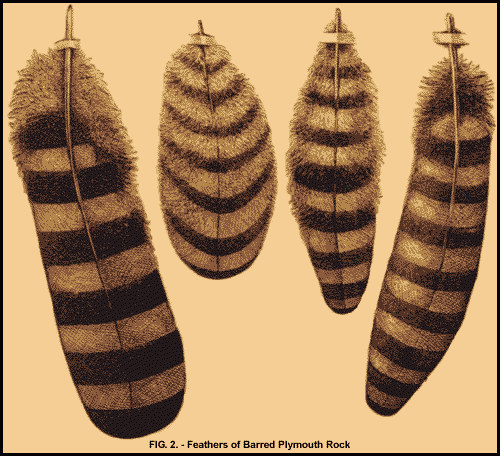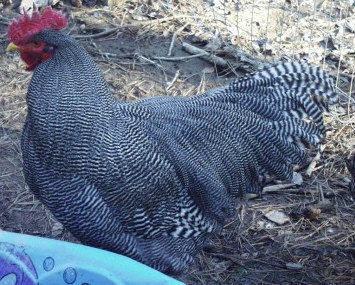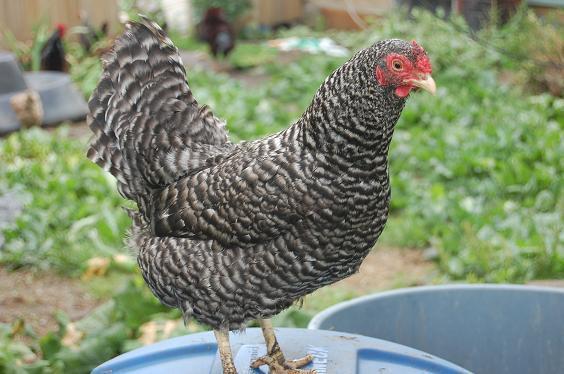i dnt see much of a differnce
Navigation
Install the app
How to install the app on iOS
Follow along with the video below to see how to install our site as a web app on your home screen.
Note: This feature may not be available in some browsers.
More options
You are using an out of date browser. It may not display this or other websites correctly.
You should upgrade or use an alternative browser.
You should upgrade or use an alternative browser.
Whats the difference between Cuckoo and Barred?
- Thread starter stephanie1992
- Start date
A Cuckoo Maran lays dark brown eggs and a barred rock lays light brown eggs. Cuckoos are also usually darker in feather color.
No the OP means color. There's more barred and cuckoo breeds out there than just Marans and Rocks

Cuckoos are usually a darker, more smudgy, improper type barring. They also feather out normally.
Barred birds are usually much more crisp and defined in barring, and a good non-production bred bird will have slow feathering.

Cuckoos are usually a darker, more smudgy, improper type barring. They also feather out normally.
Barred birds are usually much more crisp and defined in barring, and a good non-production bred bird will have slow feathering.
- Thread starter
- #4
so would u call this cukoo or barred? Mix breed


Last edited:
Looks like a barred to me. My cuckoos lines are more charcoal colored and smeared lines....
Quote:
Quote:
Appearance-wise, think of barred as being drawn with a marker using a straight edge, and cuckoo as being drawn freehand with a crayon. Genetically they are both barred, with cuckoo birds having the fast feathering gene and barred ones having its slow feathering alternative allele. Production barred birds can approach the look of cuckoo as they are not bred and selected based upon appearance.
Barring -
Alternate transverse markings of two distinct colors.
"Regular" or "Clean" Barring as in the Exhibition Barred Plymouth Rock.


"Irregular" or "Smutty" Barring as in the Dominique, Holland, Maran and (hatchery) Barred Plymouth Rock.


The term Barring also applies to the crosswise markings as in the Sliver /Gold Penciled Hamburg (Female).
Barring Gene: B
This is a Sex-link gene that stops and starts pigment production as in feather growth to give the well-known barring pattern as seen on Barred Wyandottes and Scots Greys. The extremely narrow and sharp barring seen on the Barred Plymouth Rocks is achieved by the presence of the gene ('K') for very slow feathering growth,which allows for a lot of on/off sequences in the time it takes for a feather to grow. The same barring gene ('B') when on a rapid feathering breed gives wide, coarse, fuzzy "Cuckoo Barring" as seen on Cuckoo Marans, Cuckoo Pekins (Cochins) and others. The barring gene also interacts with the gene on the E locus, all of the above examples being based on the E plus melantoics. Thus all these barring and cuckoo breeds would be self-black if they did not have the barring gene. This gene has greater pigment-restricting effect on black pigment than it does on red or gold pigment. When the barring gene is applied to the Wild Type pattern, the Crele variety is produced; and the barring on Columbian pattern combination is seen on Rhodebars, one of the autosexing breeds.
Chris
Alternate transverse markings of two distinct colors.
"Regular" or "Clean" Barring as in the Exhibition Barred Plymouth Rock.


"Irregular" or "Smutty" Barring as in the Dominique, Holland, Maran and (hatchery) Barred Plymouth Rock.


The term Barring also applies to the crosswise markings as in the Sliver /Gold Penciled Hamburg (Female).
Barring Gene: B
This is a Sex-link gene that stops and starts pigment production as in feather growth to give the well-known barring pattern as seen on Barred Wyandottes and Scots Greys. The extremely narrow and sharp barring seen on the Barred Plymouth Rocks is achieved by the presence of the gene ('K') for very slow feathering growth,which allows for a lot of on/off sequences in the time it takes for a feather to grow. The same barring gene ('B') when on a rapid feathering breed gives wide, coarse, fuzzy "Cuckoo Barring" as seen on Cuckoo Marans, Cuckoo Pekins (Cochins) and others. The barring gene also interacts with the gene on the E locus, all of the above examples being based on the E plus melantoics. Thus all these barring and cuckoo breeds would be self-black if they did not have the barring gene. This gene has greater pigment-restricting effect on black pigment than it does on red or gold pigment. When the barring gene is applied to the Wild Type pattern, the Crele variety is produced; and the barring on Columbian pattern combination is seen on Rhodebars, one of the autosexing breeds.
Chris
The easy way I like to define barring vs cuckoo is barred is black, white, black while cuckoo is black, gray, white, gray, black
are there any further differences on a genetic level? I've been meaning to dig into this myself so might as well jump on this thread and keep the info contained to a singular thread.
Well, there is autosomal barring, which is a combination of genes (Pg and Db), and does not involve B at all. BTW, B is a sex-linked gene, whihc is why the males who have two copies have more white in them while the females who can only have one are darker.
New posts New threads Active threads
-
Latest threads
-
-
-
superlorin implant and skin color change
- Started by my beautiful girls
- Replies: 2
-
buying a greenhouse to serve partly as a chicken run
- Started by Chicken-poodle
- Replies: 0
-
Power outage, what to expect? Help please.
- Started by vonmatter
- Replies: 1
-
-
Threads with more replies in the last 15 days
-
×

